Curated by German-born, France-based artist Monika Brugger, A Bit of Clay on the Skin brings together work from 18 jewelry artists from around the world. The exhibition runs until Feb. 5 at the New Taipei City Yingge Ceramics Museum and was organized by La Fondation Bernardaud, which is run by the Limoges luxury porcelain maker and seeks to enhance the profile of ceramics as a fine arts medium. The show opened at the Museum of Art and Design in New York City last year and will travel to Paris and Toronto.
Out of the artists represented by the exhibition, only one, Peter Hoogeboom, uses mainly ceramics in his creations. The Dutch artist’s work pioneered the use of ceramics in contemporary jewelry.
“I think he proved that you can work with ceramics and be avant-garde as well,” says Brugger. “He is completely trained as a jeweler and I think that is something very important. People trained as jewelers discover new materials and they have a completely different notion of what we can do.”
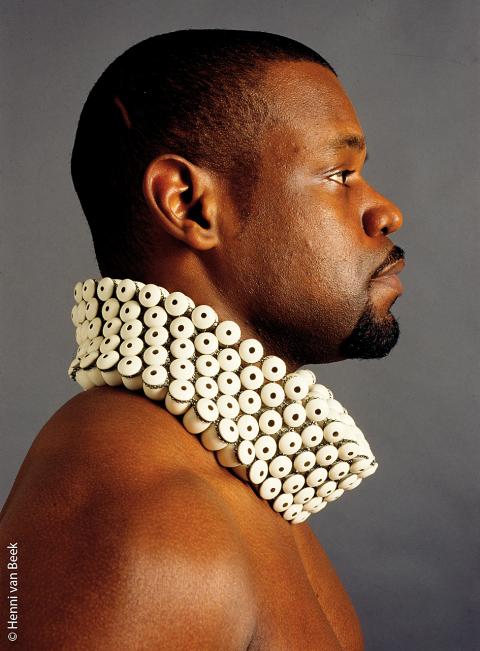
Photo courtesy of Peter Hoogeboom
A collar made from rows of perfectly uniform ceramic beads by Hoogeboom not only references the heavy collars created by some African ethnic groups, but also the elaborate starched ruffs worn by European aristocrats during the late Renaissance.
Finnish artist Tiina Rajakallio’s necklaces also offer an interpretation of historical jewelry and costume. Braided from human hair, her Purity series recalls the “sentimental” or mourning jewelry that was popular in Europe during the Victorian era. While sentimental jewelry was intricately woven from gleaming locks of human hair and mounted on gold, Rajakallio’s necklaces are made with cords of hair that look tangled and knotted. The rough texture is a contrast to jewelry “fittings” crafted from gleaming white porcelain, the same material used to manufacture bathroom fixtures.
Out of all the pieces in the exhibit, Rajakallio’s hair necklaces caused the most controversy during the selection process, says Brugger. She felt it was important to include the work because it challenges conventions of beauty.
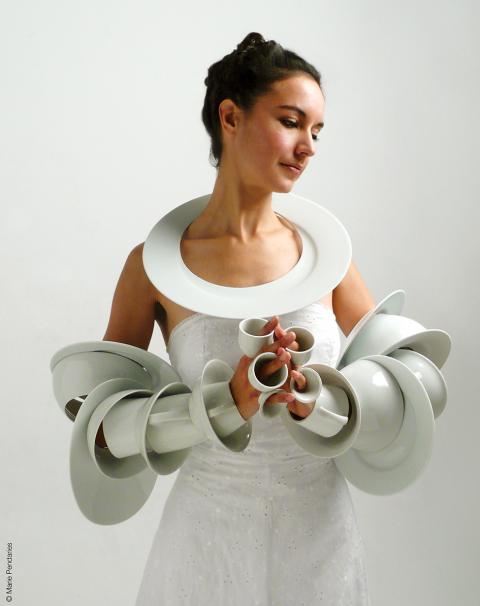
Photo courtesy of Marie Pendaries
“The white [ceramic] pieces are the representation of propriety, something that is very hygienic,” says Brugger. “The hair, if you look really close, you can see some of it is not very clean.”
Other pieces are more conceptual in nature and borrow from the visual language of jewelry. The Dowry by French artist Marie Pendaries comprises 28 pieces of plain white crockery with holes of graduating sizes cut into them. They are worn assembled like weighty but fragile body armor. In a photo taken by Pendaries and included in the exhibit, the model laden with The Dowry poses with her palms together and eyes demurely facing away from the viewer, mimicking the posture of the Virgin Mary in portrayals of the Immaculate Conception.
The Dowry is among several works in the exhibition that use jewelry to comment on gender roles. Nymphes, French artist Carole Deltenre’s series of medallion pendants, is the most forthright, with white porcelain casts of vaginas surrounded by metal filigree.
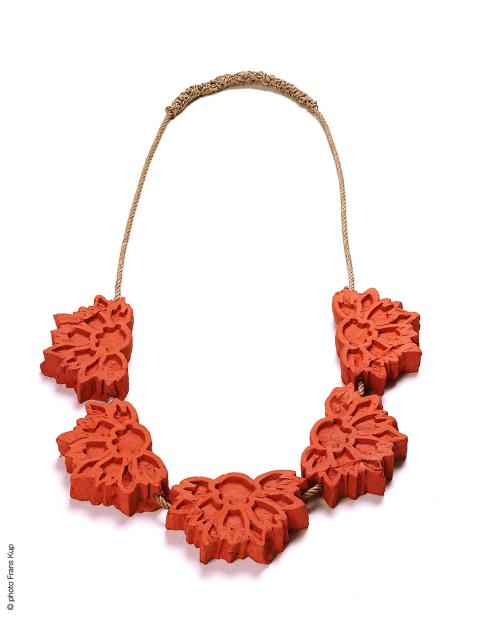
Photo courtesy of Willemijn de Greef
“Traditionally you put the most important thing in medallions,” says Brugger. “Pictures, a lock of hair, something you find really important.”
Dutch artist Manon van Kouswijk’s Re:Model is cast from a mold of a classic pearl necklace. It has to be broken and the pieces strung back together again in order to be wearable.
“You have to crack it and ‘ruin’ the work, and then you can put it back together and wear it,” says Brugger. “Pearls symbolize purity. Members of the French bourgeoisie give necklaces to girls, but only after they are about 16 or 17, because it has to do with being a woman.”
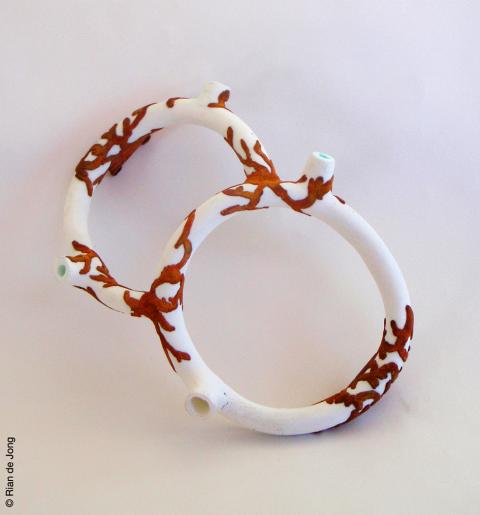
Photo courtesy of Rian de Jong
Signet rings, traditionally worn by men as a symbol of authority, are also represented in the exhibition. Swiss artist Andi Gut’s rings are crafted from dental porcelain and steel. Gut was inspired by the similarities between tools used by jewelry makers and dentists, and the curvilinear shape of the signet rings echo the shape of teeth.
Taiwanese artist Shu-lin Wu (吳淑麟) used slip casting and mokume gane, a traditional Japanese metalworking technique that creates layered patterns similar to wood grain, to craft large, hollow beads and ceramic “stones.”
“[Ceramic] is warmer than metal and I felt the material is also representative of my origin. Historically in Taiwan and China we use a lot of ceramics,” says Wu.
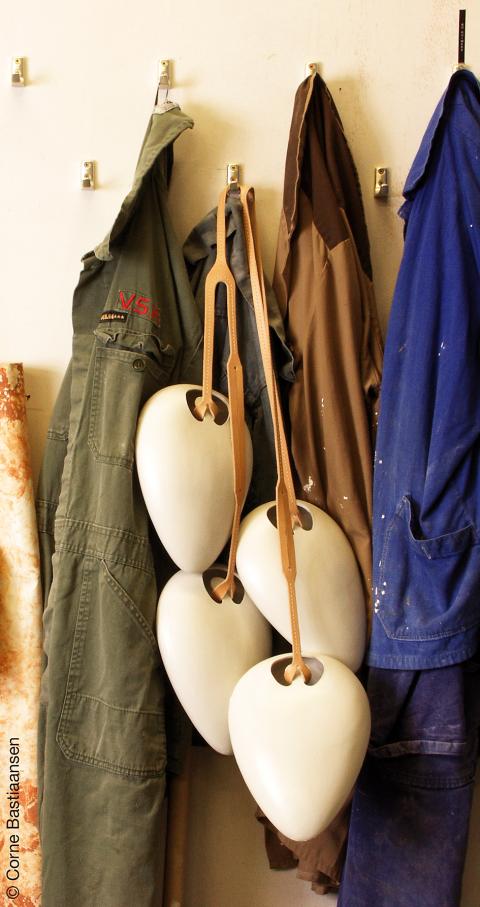
Photo courtesy of Christoph Zellweger
The colors and shape of her beads, which are strung into necklaces, offer a modernized, abstract take on Wedgewood jasperware, which was also sculpted in layers. Wu’s earrings, however, are arranged into girandoles, which feature a central piece framed by two drops and two to three pendants dangling from the bottom. The classic style contrasts with Wu’s ceramic pieces, which have edges reminiscent of Neolithic stone implements instead of the symmetrical facets of modern gem-cutting.
Other jewelry artists in the exhibition offer their own take on art and design traditions. Dutch artist Evert Nijland’s porcelain necklaces were created as a response to architect Alfred Loos’ influential 1908 essay Ornament and Crime, which derided the overuse of meaningless decorative flourishes. Nijland’s porcelain pieces include a necklace with delicately sculpted flower buds and pastel colors reminiscent of rococo figurines and architecture strung onto a simple woven linen cord. Necklaces by another Dutch artist, Willemijn de Greef, are molded from terra cotta used to build houses in Zuiderzee, a fishing region in the northwest of the Netherlands, and sport floral motifs commonly seen in the area. De Greef’s pieces are outsized and have to be worn slung across the body. Many of the pieces in the exhibition straddle the line “between jewelry and installation,” says Brugger.
“It’s about jewelry and ornament, and the question of ‘what is ornament?’” she says. “What does it mean to ‘ornament’ somebody?”
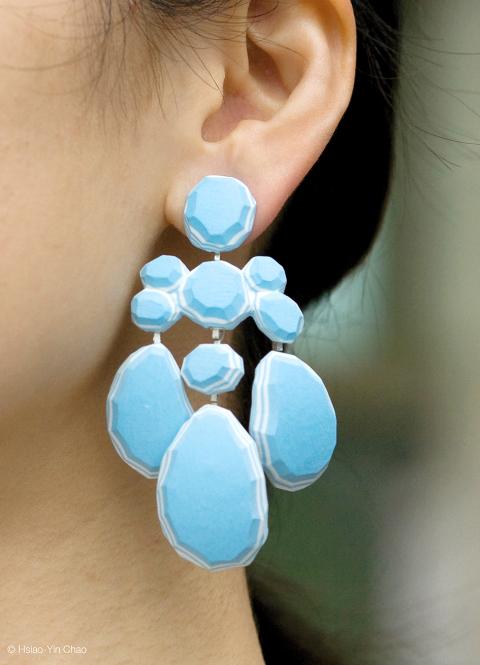
Photo courtesy of Shu-lin Wu

As Donald Trump’s executive order in March led to the shuttering of Voice of America (VOA) — the global broadcaster whose roots date back to the fight against Nazi propaganda — he quickly attracted support from figures not used to aligning themselves with any US administration. Trump had ordered the US Agency for Global Media, the federal agency that funds VOA and other groups promoting independent journalism overseas, to be “eliminated to the maximum extent consistent with applicable law.” The decision suddenly halted programming in 49 languages to more than 425 million people. In Moscow, Margarita Simonyan, the hardline editor-in-chief of the

Six weeks before I embarked on a research mission in Kyoto, I was sitting alone at a bar counter in Melbourne. Next to me, a woman was bragging loudly to a friend: She, too, was heading to Kyoto, I quickly discerned. Except her trip was in four months. And she’d just pulled an all-nighter booking restaurant reservations. As I snooped on the conversation, I broke out in a sweat, panicking because I’d yet to secure a single table. Then I remembered: Eating well in Japan is absolutely not something to lose sleep over. It’s true that the best-known institutions book up faster

The latest Formosa poll released at the end of last month shows confidence in President William Lai (賴清德) plunged 8.1 percent, while satisfaction with the Lai administration fared worse with a drop of 8.5 percent. Those lacking confidence in Lai jumped by 6 percent and dissatisfaction in his administration spiked up 6.7 percent. Confidence in Lai is still strong at 48.6 percent, compared to 43 percent lacking confidence — but this is his worst result overall since he took office. For the first time, dissatisfaction with his administration surpassed satisfaction, 47.3 to 47.1 percent. Though statistically a tie, for most

Though the total area of Penghu isn’t that large, exploring all of it — including its numerous outlying islands — could easily take a couple of weeks. The most remote township accessible by road from Magong City (馬公市) is Siyu (西嶼鄉), and this place alone deserves at least two days to fully appreciate. Whether it’s beaches, architecture, museums, snacks, sunrises or sunsets that attract you, Siyu has something for everyone. Though only 5km from Magong by sea, no ferry service currently exists and it must be reached by a long circuitous route around the main island of Penghu, with the